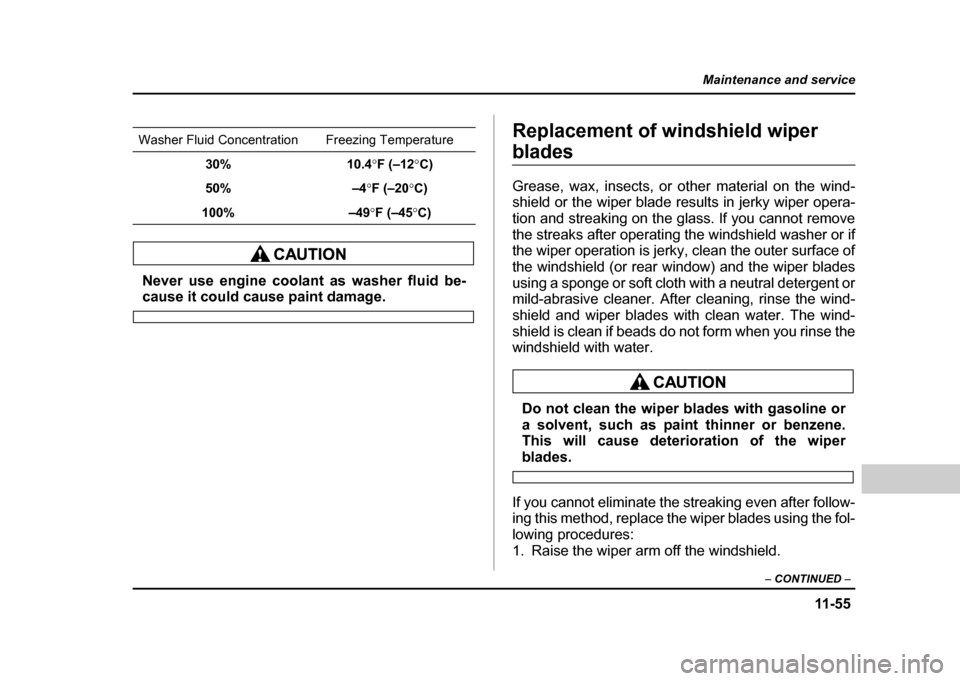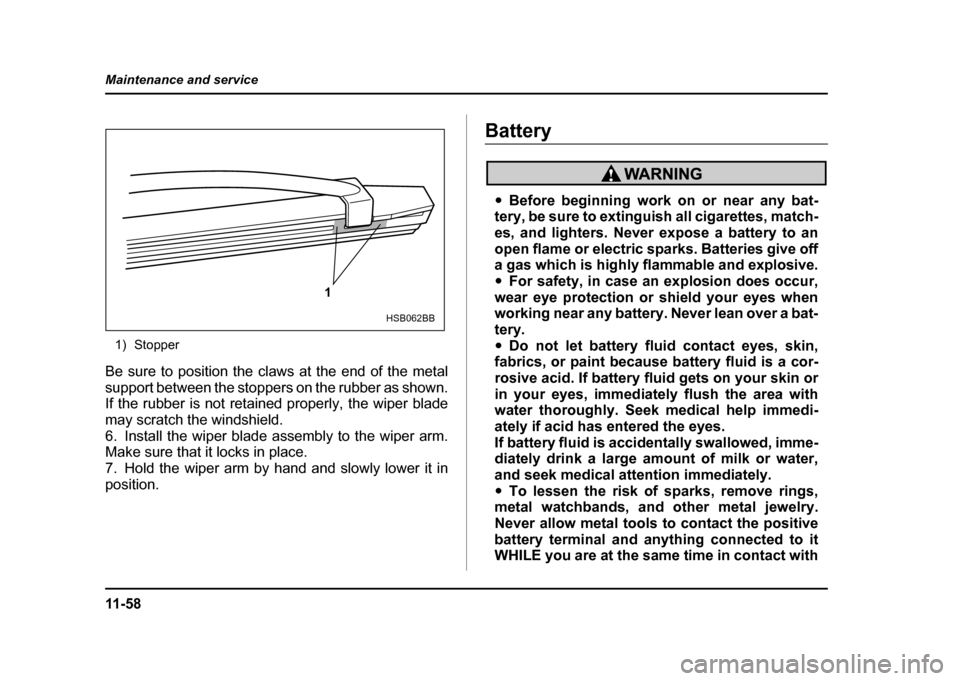Page 440 of 491

11 -5 5
Maintenance and service
– CONTINUED –
Never use engine coolant as washer fluid be-cause it could cause paint damage. Replacement of windshield wiper
blades
Grease, wax, insects, or other material on the wind-
shield or the wiper blade results in jerky wiper opera-
tion and streaking on the glass. If you cannot remove
the streaks after operating the windshield washer or if
the wiper operation is jerky, clean the outer surface of
the windshield (or rear window) and the wiper blades
using a sponge or soft cloth with a neutral detergent or
mild-abrasive cleaner. After cleaning, rinse the wind-
shield and wiper blades with clean water. The wind-
shield is clean if beads do not form when you rinse the
windshield with water.
Do not clean the wiper blades with gasoline or
a solvent, such as paint thinner or benzene.
This will cause deterioration of the wiper
blades.
If you cannot eliminate the streaking even after follow-
ing this method, replace the wiper blades using the fol-
lowing procedures:
1. Raise the wiper arm off the windshield.
Washer Fluid Concentration Freezing Temperature
30% 10.4 °F (–12 °C)
50% –4 °F (–20 °C)
100% –49 °F (–45 °C)
Page 441 of 491
11 - 5 6
Maintenance and service
1) Stopper
2. Remove the wiper blade assembly by holding its
pivot area and pushing it in the direction shown by the
arrow while depressing the wiper blade stopper. 1) Metal support
3. Grasp the locked end of the blade rubber assembly
and pull it firmly until the stoppers on the rubber are
free of the metal support.
1
HSB058CB
1
HSB059BB
Page 442 of 491
11 -5 7
Maintenance and service
– CONTINUED –
1) Metal spines
4. If the new blade rubber is not provided with two
metal spines, remove the metal spines from the old
blade rubber and install them in the new blade rubber. 5. Align the claws of the metal support with the
grooves in the rubber and slide the blade rubber as-
sembly into the metal support until it locks.
1
HSB060BBHSB061BA
Page 443 of 491

11 - 5 8
Maintenance and service
1) Stopper
Be sure to position the claws at the end of the metal
support between the stoppers on the rubber as shown.
If the rubber is not retained properly, the wiper blade
may scratch the windshield.
6. Install the wiper blade assembly to the wiper arm.
Make sure that it locks in place.
7. Hold the wiper arm by hand and slowly lower it in
position.
Battery
" Before beginning work on or near any bat-
tery, be sure to extinguish all cigarettes, match-
es, and lighters. Never expose a battery to an
open flame or electric sparks. Batteries give off
a gas which is highly flammable and explosive. " For safety, in case an explosion does occur,
wear eye protection or shield your eyes when
working near any battery. Never lean over a bat- tery." Do not let battery fluid contact eyes, skin,
fabrics, or paint because battery fluid is a cor-
rosive acid. If battery fluid gets on your skin or
in your eyes, immediately flush the area with
water thoroughly. Seek medical help immedi-
ately if acid has entered the eyes.
If battery fluid is accidentally swallowed, imme-
diately drink a large amount of milk or water,
and seek medical attention immediately." To lessen the risk of sparks, remove rings,
metal watchbands, and other metal jewelry.
Never allow metal tools to contact the positive
battery terminal and anything connected to it
WHILE you are at the same time in contact with
1
HSB062BB
Page 444 of 491
11 -5 9
Maintenance and service
– CONTINUED –
any other metallic portion of the vehicle be-
cause a short circuit will result. "Keep everyone including children away from
the battery. " Charge the battery in a well-ventilated area.
" Battery posts, terminals and related accesso-
ries contain lead and lead compounds, chemi-
cals known to the State of California to cause
cancer and reproductive harm. Wash hands af-
ter handling.
1) Cap
2) Upper level
3) Lower level It is unnecessary to periodically check the battery fluid
level or periodically refill with distilled water.
However, if the battery fluid level is below the lower
level, remove the cap. Fill to the upper level with dis-
tilled water.
Never use more than 10 amperes when charg-
ing the battery because it will shorten battery
life.
UPPER LEVELUPPER LEVELLO
WER
LE VELWER LEVEL
1
2 3
HSB063BB
Page 445 of 491
11 - 6 0
Maintenance and service
Fuses
Never replace a fuse with one having a higher
rating or with material other than a fuse be-
cause serious damage or a fire could result.
The fuses are designed to melt during an overload to
prevent damage to the wiring harness and electrical
equipment. The fuses are located in two fuse boxes.
One is located under the instrument panel behind the
coin tray on the driver’s seat side. To remove the coin tray, open the cover and pull the
coin tray out.
UGB547BA
UGB550BA
Page 446 of 491
11 -6 1
Maintenance and service
– CONTINUED –
The other one is housed in the engine compartment. 1) Fuse puller
2) Spare fuse
The fuse puller and spare fuses are stored in the main
fuse box cover in the engine compartment.
HSB065BA
1
2
HSB066BB
Page 447 of 491
11 - 6 2
Maintenance and service
A) Good
B) Blown
If any lights, accessories or other electrical controls do
not operate, inspect the corresponding fuse. If a fuse
has blown, replace it.
1. Turn the ignition switch to the “LOCK” position and
turn off all electrical accessories.
2. Remove the cover.
3. Determine which fuse may be blown. The back side
of each fuse box cover and the “Fuses and circuits”
section in chapter 12 in this manual show the circuit for
each fuse. 1) Fuse puller
4. Pull out the fuse with the fuse puller.
5. Inspect the fuse. If it has blown, replace it with a
spare fuse of the same rating.
6. If the same fuse blows again, this indicates that its
system has a problem. Contact your SUBARU dealer for repairs.
AB
HSB067BB
1
HSB068BB